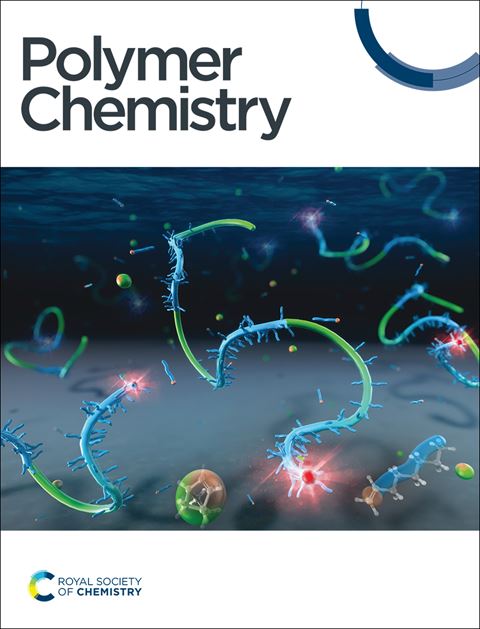热塑性聚氨酯/硅橡胶(TPU/SiR):基于聚合诱导相分离的相结构精细、质地舒适的热塑性弹性体
IF 4.1
2区 化学
Q2 POLYMER SCIENCE
引用次数: 0
摘要
本研究采用聚合诱导相分离(PIPS)法制备热塑性弹性体(TPE),不使用任何相容剂。将聚二甲基硅氧烷(PDMS)分散在聚四亚甲基醚-乙二醇(PTMG)中,在聚合过程中发生相分离,制备出以交联硅橡胶(SiR)为分散相、以热塑性聚氨酯(TPU)为连续相的热塑性弹性体(TPE)。当热塑性聚氨酯的预聚合时间为 20 分钟、SiR 分散相含量为 22 wt.%时,分散相的平均粒径为 ~0.37 μm,拉伸强度为 13.5 MPa。经过反复加工后,再生材料的拉伸强度仍可达到初始值的 80%左右。此外,该材料还具有舒适的生物触感性能,含 33 wt.% SiR 的热塑性弹性体的静态和动态摩擦系数分别为 0.512 和 0.246,远低于纯热塑性聚氨酯(Us=1.046;Ud=0.544)。与传统方法相比,该方法为制备由两种不相溶相组成的热塑性弹性体提供了一种方便、高效的途径,而且相形态的调节非常灵活、简单。本文章由计算机程序翻译,如有差异,请以英文原文为准。

Thermoplastic polyurethane/silicone rubber (TPU/SiR) thermoplastic elastomers with fine phase structures and comfortable textures based on polymerization-induced phase separation†
In this study, the polymerization-induced phase separation (PIPS) method was employed to prepare thermoplastic elastomers (TPEs) without using any compatibilizers. Polydimethylsiloxane (PDMS) was dispersed in poly-tetramethylene-ether-glycol (PTMG) and subjected to phase separation during polymerization. The TPU/SiR TPEs obtained were composed of crosslinked silicone rubber (SiR) as the dispersed phase and TPU as the continuous phase. The chemical structures, phase morphologies, and mechanical properties of the obtained TPEs are easily tunable, with an average size of dispersed phase of ∼0.37 μm and a tensile strength of 13.5 MPa when the pre-polymerization time of TPU is 20 min and the SiR dispersed phase content is 22 wt%. After repetitive processing, the tensile strength of the recycled material can still reach approximately 80% of the initial value. Moreover, the material exhibits comfortable biological tactile performance, and the static and dynamic friction coefficients of this TPE with 33 wt% SiR are 0.512 and 0.246, respectively, which are much lower than those of pure TPU (Us = 1.046; Ud = 0.544). This method provides a convenient and efficient way to prepare TPEs composed of two immiscible phases, and the regulation of the phase morphology is very flexible and simple compared with the traditional method.
求助全文
通过发布文献求助,成功后即可免费获取论文全文。
去求助
来源期刊

Polymer Chemistry
POLYMER SCIENCE-
CiteScore
8.60
自引率
8.70%
发文量
535
审稿时长
1.7 months
期刊介绍:
Polymer Chemistry welcomes submissions in all areas of polymer science that have a strong focus on macromolecular chemistry. Manuscripts may cover a broad range of fields, yet no direct application focus is required.
 求助内容:
求助内容: 应助结果提醒方式:
应助结果提醒方式:


